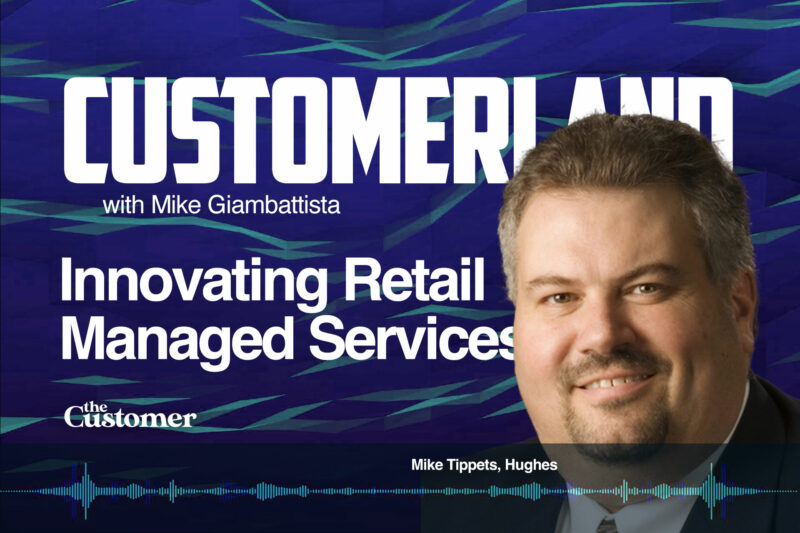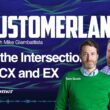Mike Tippets is VP of Enterprise Marketing at Hughes Network Systems. We had the pleasure of meeting with his colleague, Nikki at N R F back in January. We talked about some of the amazing things that Hughes has brought to market, and we committed that we would get deeper into the topics later in a follow-on conversation. This is that follow-on conversation. In this episode of Customerland – from Smart Plugs to Retail Media Networks, Hughes is leading innovations in a wide series of retail directions.
Full Transcript Below
Mike Giambattista:
Mike Tippets is VP of Enterprise Marketing at Hughes Network Systems, and I had the pleasure of meeting with his colleague, Nikki at N R F a couple weeks ago. We talked about some of the cool things that Hughes has brought to market is bringing to market, and we said we, we committed that we would get deeper into the topics later in a follow on conversation. So this is that follow on conversation. Mike has drawn the short straw to answer these questions, but Mike, thanks for for joining me. I really appreciate it.
Mike Tippets:
Oh, absolutely, absolutely. I may have drawn the short straw, but I’ll try to give long answers. I’ll have some good times,
Mike Giambattista:
<Laugh>. Appreciate that. So I guess at the top of my list is this, this smart plug device that you guys have brought to market, and maybe you can talk about what it is, what it does, but I think even more interesting than that is how it does it because it’s an AI powered gizmo. Maybe you could just kind of unpack that for us.
Mike Tippets:
Absolutely. Yeah. So we’re a managed service provider. Okay. I think you, I think you already knew that, Mike, but, and so our business is making sure that the services, whether it’s network connectivity, wifi connectivity, digital signage, connectivity, whatever that service is that we’re providing, you know, we provide a a range of them. They stay up all the time. Downtime is negative to anybody. And so we’re always looking for ways that we can eliminate the, the bottom problems, the simple problems, the, you know, whatever. And I think you’ve probably heard this before, but you know, 30 plus percent of the time when you have some kind of a device issue, a technology device a simple reboot will fix it. You know, and that, and that goes for cell phones, tablets, computers you know, switches, modems, the whole bit. And, and they don’t necessarily have to be rebooted every day or anything, but when you start to feel or see some issues, or worse, when you experience it down, the, the first thing you, you, you usually do is, Hey, let’s just reboot it.
Let’s remove the power, you know, so it goes all the way down and bring it back up. So if you have a, a, a location and, you know, they start to have an outage and they call the help desk and they say, Hey you know, we, we, we can’t get on the internet. And the, the tech will usually say, all right, let’s reboot this, that, and the other. Now what I’ve done is I’ve taken somebody away from serving the customer, from serving the constituent, from working with, you know, whatever their job is, to go be a pseudo IT person. And that has a whole bunch of challenges and, and possibly even safe risks, right? So we wanted, we wanted to try and get around that. We wanted to try and improve that. So the idea was put forward, Hey, let’s put a, a smart plug, you know, a power unit in there.
And there’s, there’s some on the market today that, you know, you can remotely trigger, but we wanted to make it smart. And so we, we, you know, we hit our engineers with the challenge of, you know, let’s make this thing everything that’s on the market today, but put some smarts on it and make it a platform that can advance, right, you know, can go forward. So the smart plug is, it’s a four port device, because our initial, you know, our initial focus is really on the IT closet. And there’s going to be, you know, two to four primary things you know, a modem, a switch you know maybe, you know, a couple of other controlling devices that are typically where, you know, we start that troubleshooting. And then we said, okay, let’s not, let’s, first of all, let’s put, you know, an ethernet port on this thing so we can ping out and we can know, Hey, wait a minute.
I can’t get on the internet anymore. I can’t get to this known place. Okay, that’s, that’s a data point. But let’s also watch the power that’s going across each of those plugs. Because if for some reason the power dips below a normal working range, we know that something’s going on there as well. And then of course, we plug this into our HughesON portal, which is a customer portal as well as our own technicians to watch and see what’s going on you know, at at sites. So the, so the device does these things. We put some AI smarts in there. Now, you can’t, you can’t put a universal rule in there that says, oh, okay, if you can’t get to the internet immediately restart. In some organizations, you say, if I can’t get to the internet two times in three minutes, make it happen. If I can’t get to the internet two times in an hour, then make it happen. So, you know, there’s a rules platform in there for people to, to set their parameters and then let the device act accordingly. The smarts the learning aspect of that is, Hey, you know what I’m watching
Mike Giambattista:
Real quick, just, just to clarify my understanding. No. So the device not, it doesn’t just monitor it, it also has the ability to actually activate a reboot based on some rules. Yes. Okay. That’s correct.
Mike Tippets:
Okay. And plug by plug. So Port, you know, power outlet by power outlet, right? There’s four of ’em. I don’t have to reboot all four. If I reboot, I can do any one of them. And, but the smarts and stuff are in, also in the data that we’re capturing along the way. You know, how often is this thing, do we see ups and downs in power? How often do we see you know, lack of it? Because maybe, maybe I go in, you know, internet unavailable on one ping, but three minutes later the next ping gets back. How often does that happen? And do we need to start looking at things you know, performance related stuff? That’s, that’s where you’re, you know, you talk about data lakes and machine learning, right? I’m starting to look at all this data and make intelligent choices based on that.
And again, preference is that we do this before anyone at the location knows that something’s not right. It just happens. And again, we, we, our every endeavor is to eliminate that really simple phone call, and then secondarily, to give us some alerts and awareness so that if it can’t self-heal, we can go proactively do something again before the end user realizes there’s an issue. Our, our help desk team’s telling us, you know, 30% of those calls, like I said, 30% are just power reboots. So we want to knock those out. We want to take, you know, the cost of the time and the cost and the inconvenience, you know, of a third of, of what’s going on.
Mike Giambattista:
So I’m imagining that essentially every managed service system, even outside of Hughes network, wants a device like this.
Mike Tippets:
We sure hope so.
Mike Giambattista:
Some system. Yeah. I mean, I’m, I’m envisioning billions of sales of these, of these devices because the utility is, is massive.
Mike Tippets:
Yeah. and as I said, you know, we started out with a four port version, right? It’s four plugs. We can, we, we built this, so you can put two of ’em. The, the size and shape, we actually made a little rack kit. So you put two of ’em side by side, and it fits nicely in a 19 inch rack. You know, yes, my 2 cents, I can see it’s coming out with future versions that have a larger port count, you know, more of them. But I also think that if, if you have a critical system or something that needs high availability that’s not in the IT closet, you know, this, this could sit in my office right here and monitor things. So we’re really excited about the future of it. You know, we made announcements we kind of introed it at N R F, you know, I think you saw that there. We’ve had immediate interest. You know, we’ve got several large customers who have been waiting for us to finish this product, make it available to them. And then when we announced that N R F, we started to get all kinds of interest from across the ocean. You know, Europe is talking to us about it. And then we’ve got a few other countries in other parts of the world that are like, wait a minute, this. You know, so we’re, we’re, we’re, we’re very positive on where this is going.
Mike Giambattista:
Yeah. It, it’s kind of a big deal. So here’s a, here’s a really dumb question. Does the device work outside of Hughes network systems? In other words, it, I mean, can you, can you plug this technology in to, you know, other, other ecosystems?
Mike Tippets:
Yeah. The, the short answer is no right now, because you need to have the Hughes on portal to, to receive the information and, and interact with it. If you, you know, you, you technically could, could put some information into it and then go plug it in somewhere and, and let it just operate with no updates and no, you know, feedback and things, right? That’s really not what it’s designed to do. Yeah. the engineers will over time create some APIs that might, that might allow it to, you know, let, let’s say we, hey, we’ll talk to a Tableau system, we’ll talk to a science logic system, something like that, where that data can be rolled around. But our, our first target going out the door was to work with customers who are taking advantage of our Huson portal and our managed services.
Mike Giambattista:
Makes, makes perfect sense. I just thought I’d ask, because you have to
Mike Tippets:
Ask. Yeah, no, it’s a great question. It’s a great question.
Sponsor Announcement:
What could you achieve if you knew what your customers expected ahead of time?
What if you could know what customers expect by category and by brand 12 to 18 months ahead of traditional brand tracking methods?
And what if you could know exactly where to adjust and where to spend in order to drive the most benefit every time?
A customer expectation audit allows you to identify areas that require strategic reinforcement, as well as pinpoint which values will contribute most to an emotional bond with your brand and optimize accordingly.
Customerland has partnered with Brand Keys, the world’s oldest loyalty focused consumer research firm to bring real world customer expectation audits to brands, brand managers, and to CX practitioners everywhere.
Wanna know where your brand stands and exactly what to do about it. Go to expectationaudit.com, that’s expectationaudit.com and download a sample audit today.
Mike Giambattista:
So one of the, one of the big themes that bubbled up at this year’s N R F is I mean, I’m, everybody was talking about retail media networks, but how those are deployed and ends up to a certain extent happening in the world of digital signage. Mm-Hmm. <affirmative>, and I know you guys are working there. I talked to Nikki about some of the ways that you’re using Hughes digital signage capabilities for employee onboarding, training, retention, that kind of stuff. Mm-Hmm. <affirmative>. So I wanted to just try and see what that, what that looks like in your world, and then and then talk a little bit about how that dovetails with what’s happening in retail media networks.
Mike Tippets:
Sure. well, first of all, you know, we, we jumped into digital signage in the early two thousands. I think it was two 2001, two, something like that. And, you know, we were doing some video solutions and doing some things for customers, and we said, what’s the next ring? And we said, you know, digital signage is gonna be popping. And so we started looking at that. And at the time you had people saying, oh yeah, you know, put it up there, sell advertising time, and, you know, it’ll pay for itself. It’ll be free. That’s not, that was not the case. And, you know, fortunately we didn’t dive into that business model, right? But what we did realize was that, you know, the, the ability to talk to people with video was, is, and it was going to be critical. You know, I I I frequently comment that if you have an alter, if you have the option of receiving information, okay, not just learning, but receiving information, 72% of the people will say they wanna watch it.
They wanna watch their way to knowledge, they wanna watch their way through information. They don’t wanna read it, they don’t want, you know, hearing, it’s probably a little better than reading it. But video is huge. And so we said, okay, let’s start talking to retailers. Let’s start talking to different people. And the, the r o ROI became your, you know, it’s always one of your first hurdles with technology, right? Oh, that’s great. That would be awesome. But, you know, can I move another sweater? Can I sell another burger because of it? And when you put a digital signage screen in a retail area and you know, you’re putting pre pictures up there, you’re showing, you know, attractive men and women wearing the clothing or using the products and so on and so forth. Say, Hey, look, we had sales increase in our sweaters.
And somebody will come back and say, yeah, but we had a cold streak. I think it was the weather driving the sale of sweaters, not the digital science. It was, it’s challenging to this day, it’s still a bit of a debate. We tripped into something and talking to one of our large customers back in the day about talking to employees in the break room in the, in the late two thousands before 2010 we started to see some retailers who were, they were getting negative employee feedback scores, okay. And they, they said, Hey, we gotta do something about the break room to improve the improve employee morale. And one of them said, we should include some screens in there. Initially it was simply to play television. Let’s just put, you know, a TV feed in there, let ’em watch ESPN Food Network, whatever they want, cuz that’ll improve morale.
And we had a marketing person we were working with who had a bit of a vision and said, you know, okay boss, I’ll do that, but can I put a little bit of a l band wrapper around it and put in company information? I don’t care. Just, you know, get it going in the break rooms. And that’s where, what we call today, break Room TV was born and it’s interest. What’s really hilarious is we, we, the first test we did, we put two screens in. One was playing TV and one was playing company information. We go back in, we start watching, and naturally the expectation was we’re gonna get in there and we’re gonna find the corporate one turned off. And the other one, everybody’s watching tv. And what we found was they were both still on, and when we talked to the employees, they were like, oh, it’s, it’s fantastic.
I never knew the company was participating in Habitat for Humanity or breast cancer awareness or, you know, this community project. I didn’t know that my senior executives thought this way, or, you know, so forth. And it’s just advanced significantly about the importance of talking to employees. But the ROI was immediate. You know, you, you query the employee informally, Hey, did you know, you know, we’re coming up on the benefits renewal time. Yes, I did. Saw it on the screen. So you know that it’s having an impact. Where before it was, you know, a piece of paper on the court board and maybe they saw it, maybe they didn’t. But when you can have that impact. So, you know, we, we dove, we dove right in there. Now the price of displays has come down over the years, obviously. And, you know, the technology is improving.
You know, we went through a a time period where you had a variety of different kind of players and hardware players and lots of different people were building smaller and smaller and, you know, we, we dealt with that. And today we have the advantage of all that and we have the advantage of smart TVs that can actually run an application. So now I can put up digital signage where I want, when I want, and I, I can move it if I really wanted to. And, you know, I don’t, all I have to do is unplug it, move it, plug it back in, because the, you know, it’s got built-in wifi so the thing gets back on the network and gets its new content list and goes to work. And, and I’ll be honest, I don’t have a lot of customers who move their screens, you know, regularly.
Right. It could happen, but probably won’t. Right? Yeah, you can just, cuz you can, doesn’t mean you will, but it does make the deployment a much simpler proposition. So, you know, that’s, so we’re seeing digital signage. I, I tell people that you have employee facing and then you have customer facing. Okay? The drivers in employee facing are, you’re trying to hang on to those good employees and you have to talk to ’em. They have to know why they’re there. They have to understand the benefit. You know, if I’m hired to work in the shoe department at a retailer, I come to work every day, I do my job, I do it well, but I start to ask myself, you know, if I didn’t show up tomorrow, what does it matter? But if you have the senior level executives of the company talking to you about how customers like to come to an area that’s well organized, that it’s clean, that it’s, you know, friendly and that’s why you make a difference, employee one, you know, that’s huge.
And it’s, it’s really impactful. Move out, move out into the showroom, move out into the floor. Customers are constantly saying, you know, I want an experience if I’m going to buy something or do business in a location rather than in my pajamas at home, I want it to be an experience. And so the use of digital signage to make that experience a reality is, is very, very important because of the flexibility that you get. And you know, that it’s just, it’s just, it’s just rolling forward at a tremendous rate. But point of sale or point of decision, these, that’s a great place for digital signage. Sure. If you’re picking up, you know, if you’re picking up a, a, you know, a gallon of milk, hey, why not tell ’em a little bit about the cookies that tastes really good with it? Or if you’re, you know, if you’re standing there thinking, what am I gonna serve for dinner?
And there’s flashes of these readymade meals and how easy it is to step over here and grab this item and take it with you you know, that’s, that’s huge. Anytime you have people waiting. So point of wait. Okay, that’s, you know, you, you can talk about infotainment and reducing the perceived wait time. You can talk about the opportunity to upsell. You know, I, I frequently will say, Hey, when you’re in an auto repair or auto service weight room, why not? You know, don’t just show ’em the Geo National Geographic Channel, show ’em a National Geographic channel, but in the corner, say, Hey, by the way, if you change your radiator fluid, you know, your car will last longer, so on and so forth. And then there’s an up and coming area point of transit or transportation. I’m not, I’m not a hundred percent sure how this is going to play out, but we’re all seeing digital billboards which is nice because as an advertiser now I can buy a slice of a billboard rather than having to own the billboard for the entire month or record. So that, that’s an up and coming area.













